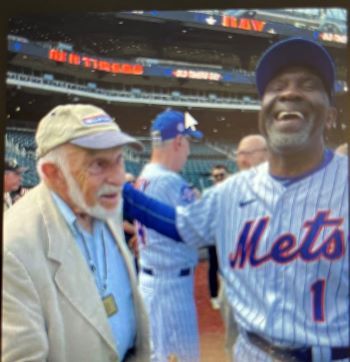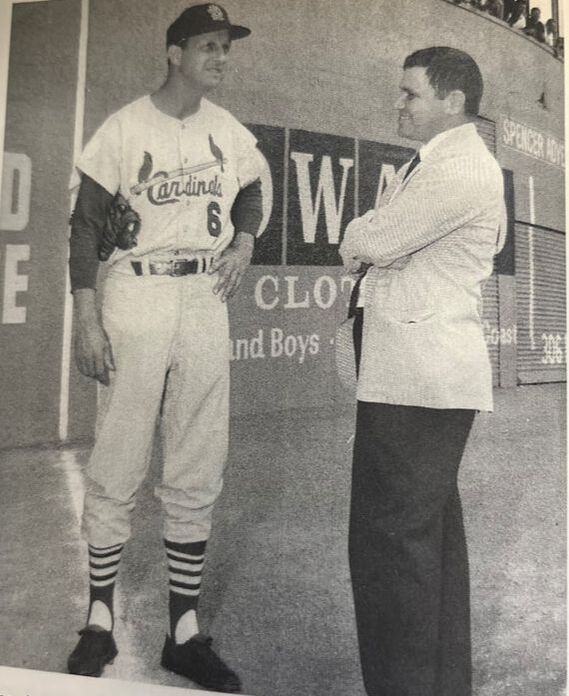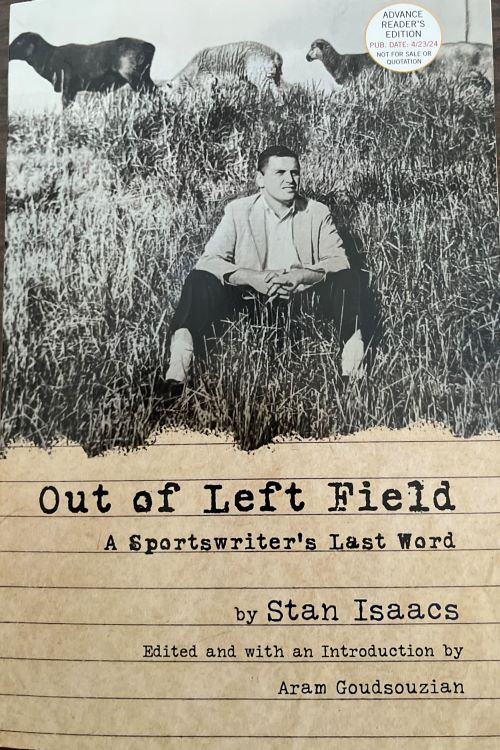|
For decades, they were teammates in the sports pages of that great paper, Newsday.
Steve Jacobson could cover anything, and ask probing questions, Stan Isaacs saw life from his natural position – way out, left field. They were my colleagues and my friends and my inspiration when I worked at Newsday in the 60s. We even played touch football together. Stan passed in 2013 but his words are being revived in an autobiography, “Out of Left Field: A Sportswriter’s Last Word,” to be published in April by the University of Illinois Press. Steve is very much with us in a current podcast celebrating a magnificent book he wrote in 2007: ”Carrying Jackie’s Torch: The Players Who Integrated Baseball – and America,” by Lawrence Hill Books. Steve’s book is, alas, out of print at the present time (as Casey Stengel used to say), but just in time for Black History Month, Jacobson -- known as Jake -- has been celebrated in a podcast by Steve Taddei, from his perch in the Bay Area. “I found ‘Carrying Jackie's Torch’ at the public library,” Taddei wrote in an e-mail. “The book fit in well with ‘Leadership Lessons From the Negro Leagues,’ because it gave me perspective to the adversity my heroes of the 1960's and 70's went through and overcame on their journey to the Major Leagues.” It is no secret that the evils of segregation, which kept Black players out of “organized” ball were not magically dispersed by Jackie Robinson’s first game with the Brooklyn Dodgers in 1947. Robinson took the first curses from opposing dugouts, the blatant reluctance of some Brooklyn teammates, and the daily problems of living in a considerably racist nation. And it was still going on when Steve Jacobson was interviewing players in the 60s. One of the most approachable was Jim (Mudcat) Grant, a star pitcher, who one day challenged Steve to expand his questions: talk to other Black players who ran into the walls of segregation. Years later, that’s what Jake did – hearing how Black players at first could not stay in hotels with their white teammates, how they had to eat brown-bag lunches in team buses, how Black players felt underrated by their managers and teammates. Always a dogged reporter, Jake sought out players we knew from our working years --Tommy Davis who always greeted writers from “my hometown” of Brooklyn, Ed Charles, the spiritual center of the 1969 championship Mets, Bob Gibson, the great pitcher who used his hard veneer to keep hitters – and reporters -- at bay, and Dusty Baker, whose winning personality has carried him to an enduring career as manager. Henry Aaron. Ernie Banks, Monte Irvin, Larry Doby. In this podcast, Steve Taddei spoke by phone with Jake (and me, a little) and near the end, Anita Jacobson, Jake's wife, tells about the hotel pool in Florida, where the Mets took spring training, circa 1965. The formidable Anita -- who cooks, and teaches cooking-- recalls what she and my wife Marianne did when another white mother pulled her child out of the pool rather than share chlorine water with a Black child. Life was like that for the Black baseball people who carried Jackie’s torch. Steve Jacobson worked hard to get memories of the Black players, and now Taddei has honored what Jacobson did in his book. Here’s the podcast: https://podcasts.apple.com/us/podcast/leadership-lessons-from-the-negro-leagues/id1646816110?i=1000644226588 *** And here is the glorious scoop of the day: Stan Isaacs’ words are back in print. In his retirement, Stan was writing his memoirs, but after the crushing death of his vibrant wife, Bobbie, in January of 2012, Stan’s heart was broken, and the book was unfinished when he slipped away 15 months later. Fortunately, Aram Goudsouzian, an editor for the University of Illinois Press, became interested in the genre of sportswriters – starting in the late 50s, in their chattery, irreverent, fearless and informed glory in the 1960’s. The Chipmunks: Stan Isaacs. Larry Merchant of the Philadelphia Daily News and Leonard Shecter of the New York Post and a dozen or more chatterers. “I’ve been working on a book about sportswriters and the big political and cultural shifts of the 1960s, and in the course of my research I read Mitchell Nathanson’s excellent biography, Bouton,” Goudsouzian wrote in an e-mail. “In the notes he had a record of Stan’s unpublished memoir, which I thought might be a good primary source for my own book. So I emailed Nathanson about it, and he put me in touch with Stan’s daughter Ellen, who sent me an electronic copy. As I read it, I had the sense that it should be published – though it needed editing, it had Stan’s distinctive voice and a lens into the shifts of the Chipmunks’ era.” Never having met Stan, Goudsouzian gave the manuscript some nips and tucks, and undoubtedly some enlightened surgery to highlight the inner Isaacs. Stan knew himself as a quirky lefty, coming out of the Depression and the politics of the 1930s, and he tells his best stories in this book. The photo on the cover? One night, covering the Yankees in the old ballpark in Kansas City, Stan chose to watch the game from the hill behind right field, patrolled by a few sheep. Vintage, definitive Stan Isaacs. They were wonderful days -- and I carried them with me to the Times in 1968, blessed with the skills and attitude of Isaacs and Jacobson and the other Chipmunks. I am extremely proud of my career at The Times, but like ball players who have loyalty to more than one ball club, I still refer to both Newsday and the Times as "we." Jacobson’s world, Isaacs’ world, are definitely from another time. Nowadays, young people do not read newspapers…and newspapers die….and even a great paper like The New York Times has chosen to blow up its sports section, with its tradition of reporters and columnists licensed to report and comment. Miraculously, in these hard times for sports sections, Stan Isaacs still patrols left field and Steve Jacobson still carries Jackie’s torch. Together again.
Walter Schwartz
2/9/2024 11:18:33 am
George, Blogging about your former Newsday teammates, Stan and Steve, and about Jackie Robinson, the Brooklyn Dodgers and Negro baseball players came at the right time for me as I am putting together an oral presentation for April 15th (Jackie Robinson Day, of course) at the Jewish Community Center in Tarrytown, Westchester County, NY, titled, "The Brooklyn Dodgers--The Inside Stories." You offered some valuable suggestions when I did a similar program ten years ago. This time, I've selected 9 exceptional books to talk about and help tell the story of what it was like back in the '40's and '50's for us Long Island (pardon me, "Queens") residents, whether we rooted for the Yankees, Giants, or, especially, the Brooklyn Dodgers. So here's my starting lineup: Roger Kahn: "The Boys of Summer"; Maury Allen with Susan Walker: "Dixie Walker of the Dodgers"; Arnold Rampersad: "Jackie Robinson, A Biography"; Neil Lanctot: "Campy--The Two Lives of Roy Campanella"; Ralph Branca and David Ritz: "A Moment in Time"; Jane Leavy: "Sandy Koufax, A Lefty's Legacy"; Michael Shapiro: "The Last Good Season; Doris Kearns Goodwin: "Wait Till Next Year". [There's a strong Westchester County slant to the stories of Branca and Campanella and the writing of Neil Allen, whom I knew, as well as the fact that Jackie and Rachel Robinson couldn't find a community in Westchester who would welcome them to their neighborhood, so with the help of Carly Simon's mother, they found a house in Connecticut.]. PLUS, my personal choice of a great baseball book with a chapter on Jackie Robinson and another on the Negro Leagues: "Baseball--A History of America's Favorite Sport" by a writer named George Vecsey, my very own teammate on another good local newspaper of the '50's, "The Hilltopper," whose motto was, "Serving Jamaica High With the Best in Scholastic Journalism". Ah, yes, those were the days, my friend! Never stop caring and never stop writing!!
Jean
2/9/2024 12:52:23 pm
Thanks. My sister rooted for the dodgers which we saw when we visited my aunt and uncle who had moved from Brooklyn to Floral park in 1949’. They had a tiny tv that we could watch when we visited
Michael
2/9/2024 01:27:18 pm
Hi George: This former Newsday delivery boy loves when you remind of those days and those writers. I read every page of the sports section (when i could wrestle it away from my older brother)! Best, Michael
Altenir Silva
2/9/2024 01:29:12 pm
George: The players at that time were truly heroes for playing in a segregated world. Unfortunately, it is a reality even now. But, as I've already said, I love your pieces about old baseball. Thank you for sharing the podcast. I've saved it to listen to later.
Walter Schwartrz
2/9/2024 05:07:21 pm
As a postscript to my earlier Comment, please let me note that what is rarely mentioned is just three months after Jackie Robinson broke the color line in the National League, Larry Doby did the same in the American League for the Cleveland Indians and, sadly, faced a similar degree of discrimination. That story is part of a recent book by Luke Epplin, titled, "Our Team", which I highly recommend to this audience. It focuses around four individuals who made a huge impact for baseball in general and the 1948 World Championship Cleveland team in particular: Doby, Satchel Paige, Bob Feller and the team's owner, Bill Veeck. It's on display at my local library during Black History Month, and most likely at other libraries, too. Comments are closed.
|
Categories
All
|












